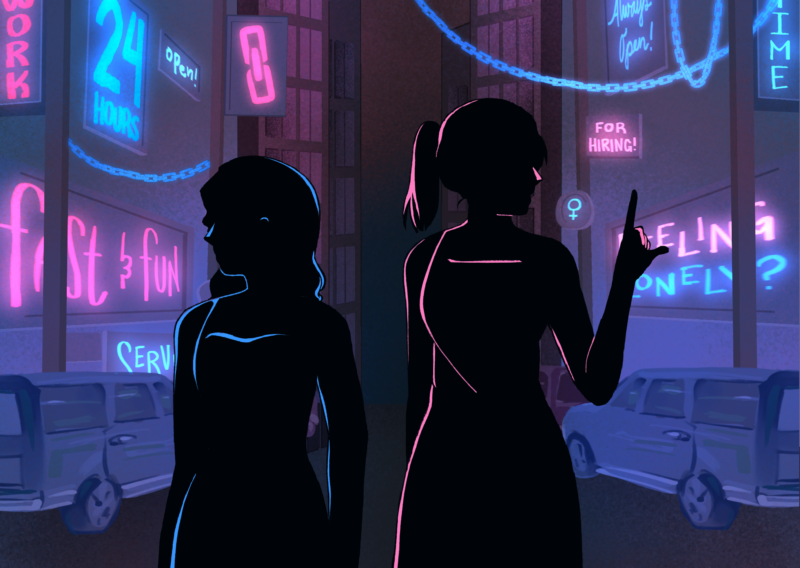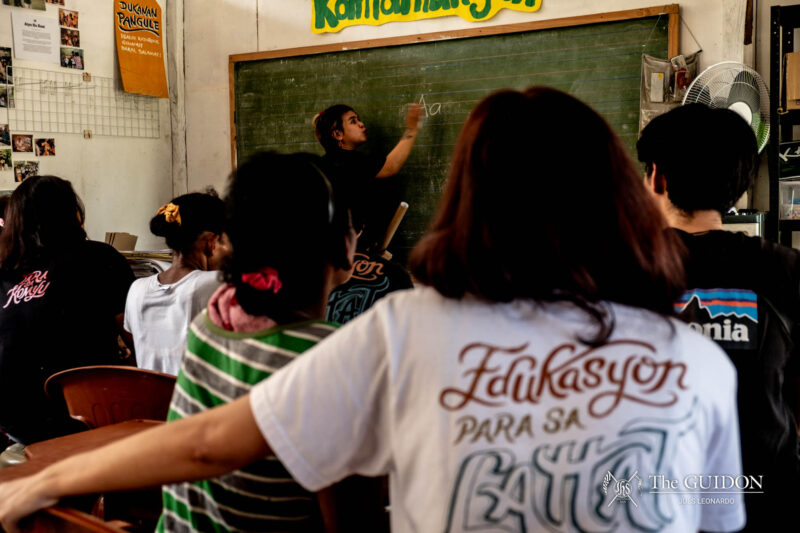
CLOSING TIME. Tia Maria’s Cantina was a Katipunan institution for the drinking crowd, especially Ateneo students. Photos by Christie K. Lim.
Bars have a tendency to pop up wherever there are students. Where there are bustling campuses, there will be those who want to unwind outside the gates of their institutions.
Many believe that the steam let off by a beer or a couple of mixed drinks cannot quite be paralleled by a night spent surfing the Internet or watching an episode or two of a good TV series.
As such, there are students who prefer to spend more time with their noses buried in their beer cups rather than in their books. While our academic workload is by no means light, this is a story most Ateneans are familiar with.
A round for everyone
As with teaching styles and study habits, drinking cultures differ from school to school. Taft Avenue is overrun with seedy bars that will serve virtually anyone at any time.
España, on the other hand, is more reserved. “[The drinking culture in España is] super different from Taft, probably because there aren’t as many drinking places,” says Camille Jurilla, a junior biology major at the University of Santo Tomas. “Sometimes the places nearer campus don’t like to serve during school hours.”
Katipunan Avenue, a national road that serves as home to three schools, is no exception. Its streets and its immediate vicinity are home to establishments such as Cannan Bistro, Drew’s, Derf’s and Intersection.
Particularly special to Atenean drinkers was Tia Maria’s Cantina, the Mexican resto-bar that used to stand directly across the college campus. When it rolled down its steel door for the last time on December 23, 2012, droves of students, past and present, came by to bid it a proper farewell.
Senior psychology major Paolo* first visited Cantina as a high school junior—no problem, considering the bar’s virtually nonexistent restrictions on serving liquor to minors.
“Kahit mahal ‘yung drinks nila, parang merong ambiance. (Even if their drinks were expensive, it had a certain ambiance.),” he explains. “Compared to the other drinking places near Katipunan, the best crowd would be found in Cantina. Kahit dumaan ka lang, makikita mo ang kilala mo. (Even if you just pass by, you would see people you know.)”
I drink to that
For many teenagers, drinking is an integral part of the college experience. They treat it almost as if the proverbial “social life” isn’t complete without it. After high school, though, going out with friends is no longer just restricted to the weekends. What’s more, they suddenly have longer breaks to kill and can walk in and out of campus as they please.
“I drank more in college because it is so easy to get a drink,” says Paul*, a junior management major. When he started his first year in the Ateneo, Paul wasted no time in becoming a regular at Katipunan’s bars. “I used to drink twice a week, even on weekdays,” he says.
Such frequent bar-hopping trips are common among Ateneo students. Most consider drinking a good way to bond or commiserate with friends, or use it to blow off the steam of a particularly hellish week. “I also drink to relieve stress, or not think about something bad that happened, such as failing a test or personal problems,” Paul says.
Others simply want to loosen up. Junior health sciences major Lorenzo* says, “Sometimes I just drink one beer to relax… but if it’s a Friday and I really have a plan to drink, I’d probably drink to get drunk.”
A few students remain patrons of the bars until they are upperclassmen, but there seems to be a novelty to college that makes taking up the bottle particularly appealing to freshmen and sophomores. Though he studied in the Ateneo for high school as well, Lorenzo used to never drink. When he started college, however, he found himself in Cantina almost every day of the week. “It seemed more fun,” he shrugs, “and there were more girls.”
However, many freshmen are not yet of legal drinking age. Lorenzo was a minor when he first drank in Cantina. But despite being and looking all of 16 years old, he was never asked to present an ID, nor does he know of anyone who has ever been carded. “They’re lenient here in Katipunan,” he says dismissively.
On the rocks
Whatever students’ reasons for their habitual visits to Katipunan’s liquor scene, a common consequence is that they end up skirting their responsibilities. Paul once was too tipsy to return to school after a particularly heavy bout of daytime drinking. “I ended up cutting all my afternoon classes and used that time to sober up before I went home,” he shares. “The sobering up period included me sleeping in Cantina and waking up occasionally to drink a glass of water or use the restroom.”
Similarly, Paolo found his first year grades taking a dive as a result of his regular drinking nights. “Cantina closes at 2:00 AM and my friends are the type of people who, unless a place is closed, will stay. I’d be too tired to study or I wouldn’t wake up for class,” he says in a mix of English and Filipino. “I learned my lesson.”
Maintaining this kind of lifestyle is near impossible when paired with schoolwork. Thus, it’s only a matter of time before students’ drinking sessions begin to lessen.
Though Paul once drank before a chemistry exam and passed despite having flunked all those he had taken sober, it seems to have only been a fluke. When he realized that he had to do more than just meet the QPI requirement, he stopped visiting bars. “I was less serious in freshman year because all I wanted was to enjoy,” he admits. “I would have that bahala na attitude and my standards for grades were below average.”
Other students don’t snap out of it quite as easily. Miguel* spent his first two years in the Ateneo drinking and smoking up marijuana on a daily basis, and his management economics blockmates rarely saw him in class. “[Drinking and smoking up] took up most of my time, and I became very unproductive,” he says.
After failing to meet the required QPI in his sophomore year, he was asked to leave the university.
Under the influence
Students who choose to pick up bottles of beer rather than books can only blame themselves for their dismal grades, but even the establishments have gotten heat for their conduct. According to Loyola Heights Barangay Captain Caesar Marquez, the bars along Katipunan have caused many a headache for local officials. Besides repeatedly serving alcohol to minors, they have violated many other barangay ordinances.
Located along Xavierville Avenue, bars such as Papu’s and Loading Point violate the ordinance against the serving of liquor in a residential area. Marquez says that Loading Point was only given a permit to operate as a dining establishment. Although the establishment’s attention has been called several times, he says that Loading Point’s owners “are insisting and using names of different politicians [to stay open].”
Whether the bars are allowed to operate so near a school at all has also been called into question. In fact, there is a government-prescribed 50-meter distance that should separate drinking establishments from schools. However, that measurement begins not from the campus perimeter, but from school buildings themselves. In the case of the Ateneo, all the bars in Loyola Heights are in the clear.
Many rumors surrounding Cantina’s abrupt closing suggest that the bar’s many run-ins with the barangay resulted into its eventual shutdown. Though Marquez is not privy to the reasons either, he does note that the bar’s management was often reprimanded for serving liquor hours after they had license to do so. “They got this special permit [to operate] until 2:00 AM, pero until 3:00 AM, 4:00 AM, nagpapainom pa rin sila (they would still be serving alcohol),” he shares.
Chasers
Where there is an abundance of alcohol, drugs are often not far behind. Though he admits to hearing talk of drug peddlers along Katipunan, Marquez answers with a confident “Nope.” when asked if the selling of illegal drugs is a rampant problem in Loyola Heights. However, scoring marijuana is about as difficult as getting away with underage drinking—that is to say, not difficult at all.
Lorenzo first learned of Katipunan’s marijuana peddlers after a night of smoking up near Wok Dis Way. “One of my other friends went down holding the joint, then one of the barangay tanods saw him. But my friend, instead of running away on the ground floor, he went back up to tell us that we got caught. Then he ran away. Then we all got caught,” he shares, laughing at the memory. “Then a couple of friends and I hid in Cantina… and they followed us there and brought us to the barangay station.”
However, the barangay tanods inside the office didn’t give them the reprimand they were expecting. “Even the barangay tanods… were offering [marijuana]. They were smoking up in front of us,” Lorenzo alleges. After that incident, peddlers along Katipunan knew that they were potential clients and would approach, asking, “Weeds, bro?”
In Paolo’s case, he usually came across peddlers when he and his friends, most of them male, were in Cantina’s parking lot. “Dumadaan ‘yung mga parking boy, tapos sasabihin nila, ‘Boss, weeds, weeds, gusto mo?’ (The parking boys would pass by and ask, ‘Boss, weed, weed, do you want weed?’)”
Other times, all he and his friends had to do was to walk along Katipunan at night. “Feeling ko, binabase nila sa hitsura ng person (I think they base it on a person’s appearance). I think for them there’s nothing to lose naman if they ask.”
“Siguro mukha kaming nagda-drugs. (We probably look like we do drugs.),” he laughs.
Sobering up
The bars themselves may come and go, but it seems like the university’s drinking culture is here to stay. To many students, grabbing a beer or ordering a tray of shots is an indispensable part of the Ateneo experience. It is the comfortable answer to a long break or a failed test, or a means to bond with friends outside the sheltered confines of the campus.
But there will always be another, darker side to an otherwise colorful world, as seen in how temptation can be literally around every corner. Perhaps it’s this danger that has still kept many students away and where they are safest: in school.
Still, when practically everything—from a beer bottle to a joint, from harmless fun to mindless euphoria—is literally at Ateneans’ fingertips, what is there to stop them?
*Names have been changed to protect the identity of the interviewees.






